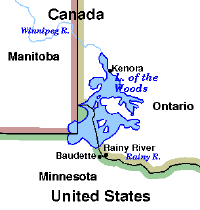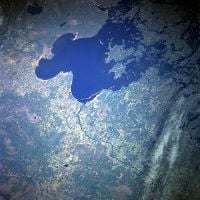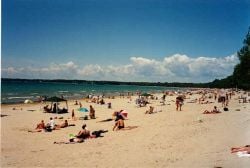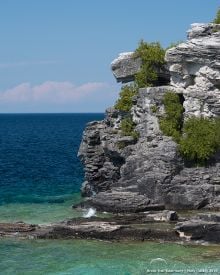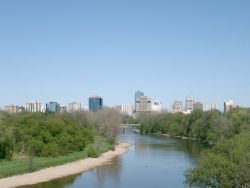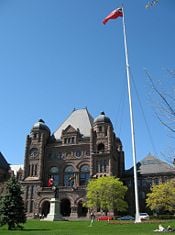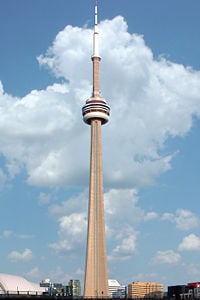Ontario
| |||||
| Motto: Ut Incepit Fidelis Sic Permanet (Latin) ("Loyal she began, thus she remains") | |||||
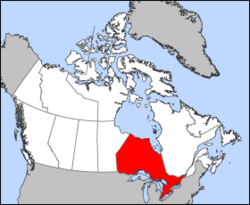
| |||||
| Capital | Toronto | ||||
|---|---|---|---|---|---|
| Largest city | Toronto | ||||
| Official languages | English (de facto) | ||||
| Government | |||||
| - Lieutenant Governor | Elizabeth Dowdeswell | ||||
| - Premier | Doug Ford (Progressive Conservative) | ||||
| Federal representation | in Canadian Parliament | ||||
| - House seats | 121 | ||||
| - Senate seats | 24 | ||||
| Confederation | July 1, 1867 (1st, with QC, NS, NB) | ||||
| Area | Ranked 4th | ||||
| - Total | 1,076,395 km² (415,598 sq mi) | ||||
| - Land | 917,741 km² (354,342 sq mi) | ||||
| - Water (%) | 158,654 km² (61,257 sq mi) (14.8%) | ||||
| Population | Ranked 1st | ||||
| - Total (2016) | 13448494[1] | ||||
| - Density | 14.8/km² (38.3/sq mi) | ||||
| GDP | Ranked 1st | ||||
| - Total (2015) | C$763.276 billion[2] | ||||
| - Per capita | C$55,322 (7th) | ||||
| Abbreviations | |||||
| - Postal | ON | ||||
| - ISO 3166-2 | CA-ON | ||||
| Time zone | Eastern: UTC-5/-4 (most of province) Eastern: UTC-5 (No DST) (Atikokan) Central: UTC-6/-5 (Most of NW Ontario) | ||||
| Postal code prefix | K L M N P | ||||
| Flower | White Trillium | ||||
| Tree | Eastern White Pine | ||||
| Bird | Great Northern Loon | ||||
| Web site | www.ontario.ca | ||||
| Rankings include all provinces and territories | |||||
Ontario is a province located in the east-central part of Canada, the largest by population and second largest (after Quebec) in total area. Ontario has the largest economy in Canada. It is bordered by the provinces of Manitoba to the west, Quebec to the east, and the American states of Michigan, New York, Ohio, Pennsylvania, and Minnesota. Most of Ontario's borders with the United States are natural, starting at the Lake of the Woods and continuing through the four Great Lakes: Superior, Huron, Erie, and Ontario (for which the province is named), then along the Saint Lawrence River.
The capital of Ontario is Toronto, the largest city in Canada. Ottawa, the capital of Canada, is located in Ontario as well. The 2006 census counted 12,160,282 residents in Ontario, which accounted for 38.5 percent of the national population.
The province takes its name from Lake Ontario, which is thought to be derived from ontarí:io, a Huron word meaning "great lake," or possibly skanadario which means "beautiful water" in Iroquoian. Along with New Brunswick, Nova Scotia, and Quebec, Ontario is one of the four original provinces of Canada when the nation was formed on July 1, 1867, by the British North America Act.
Ontario is Canada's leading manufacturing province, accounting for 52 percent of total national manufacturing shipments in 2004.
Geography
The province of Ontario consists of three main geographical regions:
- The thinly populated Canadian Shield in the northwestern and central portions, which covers over half the land area in the province; though mostly infertile land, it is rich in minerals and studded with lakes and rivers.
- The virtually unpopulated Hudson Bay lowlands in the extreme north and northeast, mainly swampy and sparsely forested
- The temperate, and therefore most populous region, fertile Great Lakes-Saint Lawrence Valley in the south where agriculture and industry are concentrated. Southern Ontario is sub-divided into four regions; Southwestern Ontario (parts of which were formerly referred to as Western Ontario), the Golden Horseshoe, Central Ontario (although not actually the province's geographic center), and Eastern Ontario.
Despite the absence of any mountainous terrain, there are large areas of uplands, particularly within the Canadian Shield, which traverses the province from northwest to southeast, and also above the Niagara Escarpment, which crosses the south. The highest point is Ishpatina Ridge at 693 m above sea level, located in northeastern Ontario.
The Carolinian forest zone covers most of the southwestern section; its northern extent is part of the Greater Toronto Area at the western end of Lake Ontario. The best-known geographic feature is Niagara Falls, part of the much more extensive Niagara Escarpment. The Saint Lawrence Seaway allows navigation to and from the Atlantic Ocean as far inland as Thunder Bay in northwestern Ontario. Northern Ontario occupies roughly 85 percent of the surface area of the province; conversely, southern Ontario contains 94 percent of the population.
Point Pelee National Park is a peninsula in southwestern Ontario (near Windsor, Ontario, and Detroit, Michigan) that extends into Lake Erie and is the southernmost extent of Canada's mainland. Pelee Island in Lake Erie extends slightly farther. Both are south of 42°N—slightly farther south than the northern border of California.
Lake of the Woods occupies parts of Ontario and Manitoba and the U.S. state of Minnesota. It separates a small land area of Minnesota from the rest of the United States. The lake drains into the Winnipeg River and then into Lake Winnipeg. Ultimately, its outflow goes through the Nelson River to Hudson Bay.
Lake of the Woods is over 70 miles long and wide and contains over 14,552 islands and 65,000 miles (105,000 km) of shoreline, which would amount to the longest coastline of any Canadian lake, except that the lake is not entirely within Canada. The lake's islands provide nesting habitat for the piping plover and large numbers of American white pelicans. There are also several hundred nesting pairs of bald eagles in this area.
Climate
Ontario has three main climate zones. Most of southwestern Ontario has a moderate humid continental climate, similar to that of the inland Mid-Atlantic States and the lower Great Lakes portion of the U.S. Midwest. The region has hot, humid summers and cold winters. It is considered a temperate climate when compared with most of Canada. Throughout the year, but especially in the fall and winter, temperatures are moderated somewhat by the lower Great Lakes, making it considerably milder than the rest of the provinces and allowing for a longer growing season than areas at similar latitudes in the continent's interior. Annual precipitation ranges from 30 inches (750 mm) to 40 inches (1,000 mm) and is well distributed throughout the year, with a summer peak.
The more northern parts of southern Ontario, all of central and eastern Ontario, and the southern parts of northern Ontario have a more severe humid continental climate. This region has warm to hot summers (although somewhat shorter than in southwestern Ontario) with cold and somewhat longer winters and a shorter growing season. Wind-whipped snow squalls or lake effect snow can affect areas as far as 62 miles (100 km) or greater from the shore of Lake Huron, but the heaviest snows usually occur within 12 miles (20 km) from the shoreline. Some snow belt areas receive an annual average of well over 120 inches (300 cm) of snow annually.
The northernmost parts of Ontario have a subarctic climate with long, very cold winters and short, warm summers and dramatic temperature changes from time to time. In the summer, hot weather occasionally reaches even the northernmost parts of Ontario, although humidity is generally lower than in the south. It is not uncommon to see snow on the ground from October to May.
Severe thunderstorms peak in frequency in June and July in most of the province, although in southern Ontario they can occur at any time from March to November due to the collision of colder, Arctic air and warm, often moist Gulf air. The regions most prone to severe weather are southwestern and central Ontario. London has the most lightning strikes per year in Canada, and is also one of the most active areas in the country for storms. Tornadoes are common throughout the province, especially in the southwestern/south-central parts, although they are rarely destructive.
History
Pre-1867
Before the arrival of the Europeans, the region was inhabited both by Algonquian (Ojibwa, Cree, and Algonquin) and Iroquoian (Iroquois Confederacy and Huron) peoples. French explorer Étienne Brûlé explored part of the area in 1610-1612. Henry Hudson sailed into Hudson Bay in 1611 and claimed the area for England, but Samuel de Champlain reached Lake Huron in 1615 and French missionaries began to establish posts along the Great Lakes. French settlement was hampered by their hostilities with the Iroquois, who allied themselves with the British.
The British established trading posts on Hudson Bay in the late seventeenth century and began a struggle for domination of Ontario. The 1763 Treaty of Paris ended the Seven Years' War by awarding nearly all of France's North American possessions (New France) to Britain. The region was annexed to Quebec in 1774.
Population growth
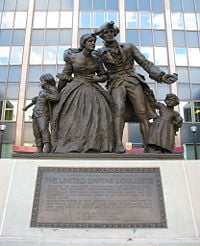
From 1783 to 1796, the United Kingdom granted Loyalists leaving the United States following the American Revolution 200 acres (0.8 km²) of land and other items with which to rebuild their lives. This measure substantially increased the population of Canada west of the St. Lawrence-Ottawa River confluence during this period, a fact recognized by the Constitutional Act of 1791, which split Quebec into The Canadas: Upper Canada southwest of the St. Lawrence-Ottawa River confluence, and Lower Canada east of it.
American troops in the War of 1812 invaded Upper Canada across the Niagara and the Detroit Rivers but were successfully defeated and pushed back by British and Native American forces. The Americans gained control of Lake Erie and Lake Ontario, however, and during the Battle of York occupied the town of York (later named Toronto) in 1813. Not able to hold the town, the departing soldiers burned it to the ground.
After the War of 1812, relative stability allowed for increasing numbers of immigrants to arrive from Britain and Ireland. Despite affordable and often free land, many newcomers from Europe found frontier life and the harsh climate difficult, and some of those with the means eventually returned home or went south. However, population growth far exceeded emigration in the decades that would follow.
Ontario's numerous waterways aided travel into the interior and supplied water power for development. As population increased, so did the industries and transportation networks. By the end of the century, Ontario vied with Quebec as the nation's leader in terms of growth in population, industry, arts, and communications.
Many in the colony, however, began to chafe against the aristocratic Family Compact that governed while benefiting economically from the region's resources, and who did not allow elected bodies the power to effect change. This resentment spurred republican ideals and sowed the seeds for early Canadian nationalism. Accordingly, rebellion in favor of responsible government rose in both Upper and Lower Canada.
Although both rebellions were put down in short order, the British government sent Lord Durham to investigate the causes of the unrest. He recommended that self-government be granted and that Lower and Upper Canada be rejoined in an attempt to assimilate the French Canadians. Accordingly, the two colonies were merged into the Province of Canada by the Act of Union (1840). Parliamentary self-government was granted in 1848.
Due to heavy waves of immigration in the 1840s, the population of the western region more than doubled by 1851 over the previous decade, and as a result for the first time the English-speaking population surpassed the French-speaking population in the east, tilting the representative balance of power.
An economic boom in the 1850s coincided with railway expansion across the province, further increasing the economic strength of central Canada.
A political stalemate between the French- and English-speaking legislators, as well as fear of aggression from the United States during the American Civil War, led the political elite to hold a series of conferences in the 1860s to effect a broader federal union of all British North American colonies. The British North America Act took effect on July 1, 1867, establishing the Dominion of Canada, initially with four provinces: Nova Scotia, New Brunswick, Quebec, and Ontario. The Province of Canada was divided at this point into Ontario and Quebec so that each linguistic group would have its own province. Both Quebec and Ontario were required to safeguard existing educational rights and privileges of their Protestant and Catholic minorities. Thus, separate Catholic schools and school boards were permitted in Ontario. However, neither province had a constitutional requirement to protect its French- or English-speaking minority. Toronto was formally established as Ontario's provincial capital at this time.
Decentralization (1867 to 1896)
Once constituted as a province, Ontario proceeded to assert its economic and legislative power. In 1872, the lawyer Oliver Mowat became premier and remained as premier until 1896. He fought for provincial rights, weakening the power of the federal government in provincial matters. His battles with the federal government greatly decentralized Canada. He consolidated and expanded Ontario's educational and provincial institutions, created districts in northern Ontario, and fought tenaciously to ensure that those parts of northwestern Ontario not historically part of Upper Canada (the vast areas north and west of the Lake Superior-Hudson Bay watershed), would become part of Ontario, a victory embodied in the Boundary Act (1889). He also presided over the emergence of the province into the economic powerhouse of Canada.
Industrialization (1896 to the present)
Mineral exploitation accelerated in the late nineteenth century, leading to the rise of important mining centers in the northeast. The province harnessed its water power to generate hydroelectric power. The availability of cheap electric power facilitated the development of industry. Ford Motor Company of Canada was established in 1904. General Motors of Canada Ltd. was formed in 1918. The motor vehicle industry would go on to become the most lucrative industry for the Ontario economy.
In July 1912, the Conservative government severely limited the availability of French-language schooling to the province's French-speaking minority. French-Canadians reacted with outrage, and the move was repealed in 1927.
The post-World War II period was one of exceptional prosperity and growth. Ontario, and the Greater Toronto Area in particular, have been the recipients of most immigration to Canada, largely immigrants from war-torn Europe in the 1950s and 1960s and, after changes in federal immigration law, a massive influx of non-Europeans since the 1970s. From a largely ethnically British province, Ontario has rapidly become quite culturally diverse.
The nationalist movement in Quebec, particularly after the election of the Parti Québécois in 1976, contributed to driving many businesses and English-speaking people out of Quebec into Ontario. As a result, Toronto surpassed Montreal as the largest city and economic center of Canada. Depressed economic conditions in the Maritime Provinces also resulted in depopulation of those provinces in the twentieth century, with heavy migration into Ontario.
Government and politics
The British North America Act 1867 stipulated a unicameral legislature for Ontario. The Legislative Assembly has 103 seats representing ridings elected in a first-past-the-post system across the province. Following the Westminster system, the leader of the party currently holding the most seats in the assembly is known as the premier. The premier chooses the cabinet or Executive Council.
Politics
Ontario has traditionally operated under a three-party system. In the last few decades the liberal Ontario Liberal Party, conservative Ontario Progressive Conservative Party, and social-democratic Ontario New Democratic Party have all ruled the province at different times.
Ontario is known as the province that offers the strongest support for the Liberal Party of Canada. The majority of the party's present 106 seats in the Canadian House of Commons represent Ontario ridings. As the province has the most seats of any province in Canada, earning support from Ontario voters is considered a crucial matter for any party hoping to win a Canadian federal election.
Economy
Ontario's rivers, including its share of the Niagara River, make it rich in hydroelectric energy. Despite its diverse range of power options, because of problems related to increasing consumption, lack of energy efficiency, and aging nuclear reactors Ontario has been forced in recent years to purchase power from its neighbors, Quebec and Michigan, to supplement its power needs during peak consumption periods.
An abundance of natural resources, excellent transportation links to the American heartland and the inland Great Lakes, making ocean access possible via ship containers, have all contributed to making manufacturing the principal industry, found mainly in the "Golden Horseshoe" region, which is the largest industrialized area in Canada. Important products include motor vehicles, iron, steel, food, electrical appliances, machinery, chemicals, and paper.
As a result of steeply declining sales, General Motors and Ford Motor Co. have made thousands of layoffs. In January 2009, GM said it was reducing production at its Oshawa, Ontario, facility. Toyota, however, has built a new plant in Woodstock, and Honda opened a state-of-the art engine plant at its facility in Alliston in September 2008.
Some economists believe that the North American Free Trade Agreement contributed to a decline in manufacturing. The biggest contributing factor is increased globalization, particularly increased manufacturing from China and India, which has led to the de-industrialization of Ontario and the gradual shift to a dominant service-oriented economy. These factors considered, Ontario remains an industrial giant within North America; therefore, its overall economic health is still responsive to changes that occur in this sector.
Toronto, the capital of Ontario, is the center of Canada's financial services and banking industry. Suburban cities in the Greater Toronto Area are large product distribution centers, in addition to having manufacturing industries. The information technology sector is also important, particularly in Markham, Waterloo, and Ottawa. Hamilton is the largest steel manufacturing city in Canada, and Sarnia is a center for petrochemical production. Construction employs at least seven percent of the work force, but due to undocumented workers, the figure is likely over 10 percent. This sector thrived due to steadily increasing new house and condominium construction combined with low mortgage rates and climbing prices, particularly in the Greater Toronto area.
Mining and the forest products industry, notably pulp and paper, are vital to the economy of northern Ontario. More than any other region, tourism contributes heavily to the economy of central Ontario, peaking during the summer months owing to the abundance of fresh water recreation and wilderness found in reasonable proximity to the major urban centers. At other times of the year, hunting, skiing, and snowmobiling are among the draws. This region has some of the most vibrant fall color displays anywhere on the continent and tours directed at overseas visitors are organized to see them. Tourism also plays a key role in border cities with large casinos, among them Windsor and Niagara Falls, which attract many U.S. visitors.
Transportation
Historically, the province has used two major east-west routes, both starting from Montreal in the neighboring province of Quebec. The northerly route, which was pioneered by early French-speaking fur traders, travels northwest from Montreal along the Ottawa River, then continues westward toward Manitoba. The much more heavily traveled southerly route, which was popularized by English-speaking Loyalists from the American colonies and later other European immigrants, travels southwest from Montreal along the Saint Lawrence River, Lake Ontario, and Lake Erie before entering the United States in Michigan. Most of Ontario's major transportation infrastructure is oriented east-west and roughly follows one of these two original routes.
- Water transportation
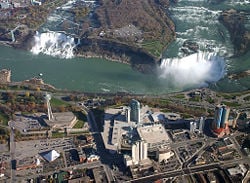
The St. Lawrence Seaway, which extends across most of the southern portion of the province and connects to the Atlantic Ocean, is the primary water transportation route for cargo, particularly iron ore and grain. In the past, the Great Lakes and Saint Lawrence River were also a major passenger transportation route, but over the past half century they have been nearly totally supplanted by vehicle, rail, and air travel.
- Rail transportation
Via Rail operates the inter-regional passenger train service on the Quebec City-Windsor Corridor. In addition Amtrak connects Ontario with key New York cities, including Buffalo, Albany, and New York City. Ontario Northland provides rail service to destinations as far north as Moosonee near James Bay. Freight rail is dominated by the founding cross-country CN and CP rail companies, which during the 1990s sold many short rail lines from their vast network to private companies operating mostly in the south. Regional commuter rail is limited to the provincially owned GO Transit, which serves a train/bus network spanning the Golden Horseshoe region, with its hub in Toronto. The TTC in Toronto operates the province's only subway and streetcar system, one of the busiest in North America. Outside of Toronto, the O-Train LRT line operates in Ottawa, with ongoing expansion of the current line and proposals for additional lines.
- Air transportation
Lester B. Pearson International Airport is the nation's busiest and the world's 29th busiest, handling over 30 million passengers per year. Other important airports include Ottawa International Airport and John C. Munro International Airport in Hamilton, which is an important courier and freight aviation center. Most Ontario cities have regional airports. Isolated towns and settlements in the northern areas of the province rely partly or entirely on air service for travel, goods, and even ambulance services, since much of the far northern area of the province cannot be reached by road or rail.
Agriculture
Once the dominant industry, agriculture occupies a small percentage of the population. The number of farms decreased from 68,633 in 1991 to 59,728 in 2001, but farms have increased in average size and many are becoming more mechanized. Cattle, grains, and dairy were the common types of farms in the 2001 census. The fruit, grape, and vegetable growing industry is located primarily on the Niagara Peninsula and along Lake Erie, where tobacco farms are also situated. Tobacco production has decreased leading to an increase in some other new crop alternatives gaining popularity, such as hazelnuts and ginseng. The Ontario origins of Massey-Ferguson Ltd., once one of the largest farm implement manufacturers in the world, indicate the importance agriculture once had to the Ontario economy.
Southern Ontario's limited supply of agricultural land is going out of production at an increasing rate. Urban sprawl and farmland severances (authorized separations into smaller adjoining properties) contribute to the loss of thousands of acres of productive agricultural land in Ontario each year.
Demographics
The majority of Ontarians are of British (English, Scottish, Welsh) and Irish ancestry.
The majority are Christian, with a larger number of Roman Catholics Protestants. A large number report no religious affiliation.
The vast majority of Ontarians are of British or other European descent. Slightly less than 5 percent of the population of Ontario is Franco-Ontarian, that is those whose native tongue is French, although those with French ancestry account for 11 percent of the population. Ontario has no official language, but English is considered the de facto language. Numerous French-language services are available under the French Language Services Act of 1990 in designated areas where sizable francophone populations exist.
Immigration is a huge population growth force in Ontario as it has been over the last two centuries, in relation to natural increase or inter-provincial migration. More recent sources of immigrants, with already large or growing communities in Ontario include Caribbeans (a majority of whom are Jamaicans), South Asians (for example, Pakistanis, Indians, Bangladeshis, and Sri Lankans), East Asians (mostly Chinese and Filipinos), Central/South Americans, Eastern Europeans such as Russians and Bosnians, and groups from Iran, Somalia, and West Africa. Most groups have settled in the Greater Toronto area. A smaller number have settled in other cities such as London, Kitchener, Hamilton, and Ottawa.
Education
Elementary and secondary
The Ministry of Education has three core priorities: Providing higher levels of student achievement, reducing gaps in achievement, and increasing confidence in publicly funded education.[3]
More than 540,000 primary students are now in classes of 20 or fewer, compared to only 166,000 students five years ago. Elementary teachers receive more support for teaching reading, writing, and math. Focused high school programs will give students more choices and opportunities to explore careers. This includes specialist high skills majors and dual credits, which have helped raise the graduation rate to 75 percent. Since 2003, the ministry has funded more than 200 new schools and nearly 12,000 renovation projects.
Higher education
In Ontario, higher education includes postsecondary education and skills training regulated by the Ministry of Training, Colleges, and Universities and provided by universities, colleges of applied arts and technology, and private career colleges. The ministry administers laws covering 22 public universities, 17 privately funded degree-granting institutions, 24 colleges, and over 500 private career colleges.
The Canadian constitution provides each province with the responsibility for higher education, and there is no corresponding national federal ministry of higher education.
Ontario has two types of publicly funded community colleges: Colleges of Applied Arts and Technology and Institutes of Technology and Advanced Learning. Some courses of study lead to official certifications in skilled trades that are regulated by professional associations. Institutes of Technology and Advanced Learning offer a limited number of degree programs, either in conjunction with a nearby university or on their own.
Most of these colleges were founded in the 1960s, after Ontario's then Minister of Education, William Grenville Davis, announced a plan to create a post-secondary educational system different from that of universities. As of the early 2000s, these colleges may—and many do—offer one or more bachelor's programs in an applied area of study.
Culture
The National Arts Centre in Ottawa is Canada's largest showcase for the performing arts. Home of the National Arts Centre Orchestra, it also features opera, ballet, and contemporary dance as well as theater in both English and French.
Toronto attracts the third largest theater-going audience in the English-speaking world. Drama, Broadway shows, and major international musicals are all performed in downtown theaters. One of Canada's most influential alternative theaters, Theatre Passe Muraille, is also located in Toronto. The city also boasts a world-class symphony as well as outstanding opera and ballet companies.
The Art Gallery of Ontario is the tenth largest art museum in North America, home to more than 40,000 works representing almost 2,000 years of art. It also houses the world's largest public collection of Henry Moore sculptures. The National Gallery of Canada in Ottawa maintains a collection of historic and contemporary works of art, many with special reference to Canada. Hundreds of museums throughout the province provide diverse cultural experiences and showcase special interests.
Each year, jazz festivals are held in Orillia and Toronto and classical music festivals in Elora. Theater productions are presented at the Shaw Festival in Niagara-on-the-Lake and at the Stratford Festival, North America's largest classical repertory theater.
Ontario's ethnic diversity is celebrated with many local festivals, such as the Scottish Highland Games in Fergus and Maxville, Toronto International Carnival (one of North America's biggest cultural street festivals, attracting one million revelers each year) and the Oktoberfest in Kitchener-Waterloo.
Tourism and recreation
Northern Ontario offers the visitor lakes and rivers, the boreal forest, mountains and hills, skiing, snowshoeing, hiking trails, and other outdoor pursuits.
Looking ahead
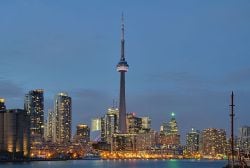
The government's economic development plan focuses on new technologies as well as attracting investment in existing industries, such as automotive production. [4] This includes promoting electric vehicles, through efforts such as City of Toronto's Consolidated Green Fleet Plan.[5]
Notes
- ↑ Population and Dwelling Count Highlight Tables, 2016 Census Statistics Canada. Retrieved March 15, 2019.
- ↑ Gross domestic product, expenditure-based, by province and territory (2015) Statistics Canada. Retrieved March 15, 2019.
- ↑ About the Ministry Ontario Ministry of Education. Retrieved March 15, 2019.
- ↑ John Irwin, Ontario releases plans for encouraging auto investment Automotive News, February 14, 2019. Retrieved March 15, 2019.
- ↑ City paves the way for a greener fleet with new electric vehicles EE Online, September 26, 2017. Retrieved March 15, 2019.
ReferencesISBN links support NWE through referral fees
- Ciment, James (ed.). Colonial America: An Encyclopedia of Social, Political, Cultural, and Economic History. New York, NY: M.E. Sharpe, 2006. ISBN 0521232287
- Library and Archives Canada. Virtual Vault. Retrieved March 15, 2019.
- Taylor, Alan. The Divided Ground: Indians, Settlers and the Northern Borderland of the American Revolution. New York: Alfred A. Knopf, 2006. ISBN 978-0679454717
- Tobin, Jacqueline, and Hettie Jones. From Midnight to Dawn: The Last Tracks of the Underground Railroad. New York: Doubleday, 2007. ISBN 978-0385514316
External links
All links retrieved November 17, 2022.
| ||||||||||
Credits
New World Encyclopedia writers and editors rewrote and completed the Wikipedia article in accordance with New World Encyclopedia standards. This article abides by terms of the Creative Commons CC-by-sa 3.0 License (CC-by-sa), which may be used and disseminated with proper attribution. Credit is due under the terms of this license that can reference both the New World Encyclopedia contributors and the selfless volunteer contributors of the Wikimedia Foundation. To cite this article click here for a list of acceptable citing formats.The history of earlier contributions by wikipedians is accessible to researchers here:
The history of this article since it was imported to New World Encyclopedia:
Note: Some restrictions may apply to use of individual images which are separately licensed.


